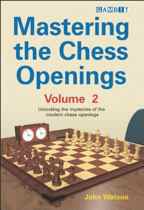Mastering the Chess Openings — Volume 2
John Watson

Three American chess authors stand out in their respective areas. IM Jeremy Silman is tops for entertaining and instructive improvement books, John Hilbert is the best for diligently researched chess history, and IM John Watson is the champion for thought provoking weighty tomes on how chess has advanced in the past fifty years. Watsons Secrets Of Modern Chess Strategy and Chess Strategy In Action were both greeted with high praise when they were published by Gambit in 1998 and 2003 respectively. Last year Mastering The Chess Openings: Volume 1 appeared, a sort of update of Reuben Fines classic Ideas Behind The Chess Openings. Now Volume 2, which is devoted to 1.d4, has just come out.
Mastering The Chess Openings: Volume 2 covers the Queens Gambit Declined, Nimzo-Indian, Queens Indian, Gruenfeld, Kings Indian and Modern Benoni. It also offers a brief look at some of Blacks second move alternatives after 1.d4 d5 2.c4 including the Baltic Defense (2…Bf5), the Chigorin (2…Nc6) and the Albin (2…e5), but not the Queens Gambit Accepted. Even in a 300-page book lines have to be drawn, so there is nothing on the Dutch, Benko Gambit, Bogo-Indian or Catalan in the present volume. Emphasis has been placed on the most important main lines. This means the Classical system (e4, Nf3 and Be2) and the Saemisch against the Kings Indian but not the Fianchetto variation. Having said what is not in the book let us now examine the riches that lie within.
One of the strongest chapters in Mastering The Chess Openings: Volume 2 is the one on the Queens Gambit Declined. I particularly liked Watsons treatment of the Exchange variation, which he divides into the Carlsbad (Nf3) and Modern (Nge2) variations. Not so long ago White either castled short and played for a minority attack with b4-b5 or castled long and went for a kingside attack. Today, add the plan of playing in the center with e3-e4 sometimes in conjunction with b4 (see Kasparov-Short from their 1993 World Championship match) and prophylactic moves like a3 and h3.
The theme of prophylaxis and a3 and h3 returns again in Watsons chapter on the Semi-Slav. One popular anti-Meran setup is 1.d4 d5 2.c4 c6 3.Nc3 Nf6 4.e3 e6 5.Nf3 Nbd7 6.Qc2 Bd6 7.Be2 0-0 8.0-0 dxc4 9.Bxc4 Qe7. Clearly Black is preparing for …e5 in this position a sort of reversed Colle. Try to guess Whites next two moves. 10.a3 e5 11.h3!. Whites last two moves look like they break all the rules about correct opening play, but in fact they are very much to the point as 10.a3 covers b4 and creates a safe haven for the Bishop on a2 and 11.h3 stops …Bg4 (after …exd4 and …Nb6) and allows 11.e4 to be met by 12.Ng5 (no …Bxh2+). As Watson points out, White challenges Black to find a useful move.
One mark of a very strong player is the ability to learn something new and apply it to different but relevant positions. A new idea might only apply to that specific position for the non-Master while an IM might immediately see several analogies and a top GM dozens often unconsciously. Watson mentions the Colle variation 1.d4 d5 2.Nf3 Nf6 3.e3 c5 4.c3 e6 5.Nbd2 Nc6 6.Bd3 Bd6 7.dxc5 Bxc5 8.0-0 0-0 9.e4 Qc7 10.Qe2. What should Black play? You got it 10…h6!
I can strongly recommend Mastering The Chess Openings: Volume 2 to all chess players from 1800 on up.
Also check out the reviews for Mastering The Chess Openings: Volume 1, Mastering The Chess Openings: Volume 3, and Mastering The Chess Openings: Volume 4.
